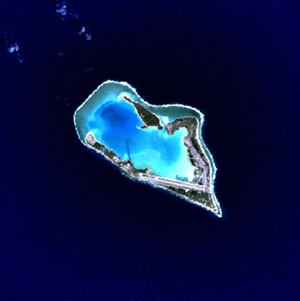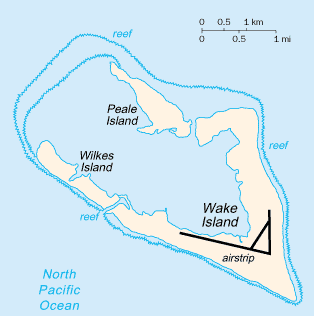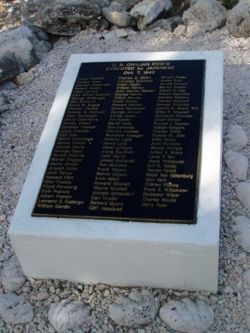Wake Island
2007 Schools Wikipedia Selection. Related subjects: Geography of Oceania (Australasia)
Wake Island (also known as Wake Atoll) is a coral atoll having a coastline of 12 miles (19 kilometers) in the North Pacific Ocean, located about two-thirds of the way from Honolulu (2,300 statute miles or 3,700 km west) to Guam (1,510 miles or 2,430 km east). It is an unorganized, unincorporated territory of the United States, part of the United States Minor Outlying Islands, administered by the Office of Insular Affairs, U.S. Department of the Interior. Wake is located to the west of the International Date Line and is one day ahead of the 50 states. Access to the island is restricted, and all current activities on the island are managed by the United States Air Force, the United States Army, and Chugach McKinley, Inc., a civilian base operations and maintenance services company.
Although Wake is officially called an island in the singular form, it is actually an atoll comprising three islands (Wake, Wilkes, and Peale) surrounding a central lagoon. Referring to the atoll as an island is the result of a pre-World War II desire by the United States Navy to distinguish Wake from other atolls, most of which were Japanese territory. The largest island (Wake Island) is the centre of activity on the atoll and features a 9,800 foot (3,000 m) runway.
Geography
- Geographic coordinates:
- Area (land): 2.5 mi² (6.5 km²)
- Coastline: 12.0 mi (19.3 km)
- Maritime claims
- exclusive economic zone: 200 nm (370.4 km)
- territorial sea: 12 nm (22.2 km)
- Elevation extremes:
- lowest point: Pacific Ocean, 0 feet (0 meters)
- highest point: Ducks Point, 20 feet (6 m)
Climate
Wake Island lies in the tropical zone but is subject to periodic temperate storms during the winter. Sea surface temperatures are warm all year long, reaching above 80 °F in summer and fall. Typhoons occasionally pass over the island.
Typhoon Ioke
On August 28, 2006, the United States Air Force evacuated all 188 residents as category 5 Super Typhoon Ioke headed toward Wake. By August 31, the southwestern eyewall of the storm passed over the island, with winds well over 185 miles per hour (300 km/h) , driving a storm surge and waves directly into the lagoon.
History
Pre-European discovery
Some scant indigenous Marshallese oral tradition suggests that prior to European exploration, nearby Marshall Islanders traveled to what is now Wake Island, which the travelers called Enen-kio after a small orange shrub-flower said to have been found on the atoll. In ancient Marshallese religion, rituals surrounding the tatooing of tribal chiefs, called Iroijlaplap, were done using certain fresh human bones, which required a human sacrifice. A man could save himself from being sacrificed if he obtained a wing bone from a certain very large seabird said to have existed on Enen-kio. Small groups would therefore brave traveling to the atoll in hope of obtaining and returning with this bone, thus saving the life of the potential human sacrifice.
Based upon this oral tradition along with concepts of first-usage lands rights claims commonly held in Micronesian cultures as legitimate for settling indigenous land disputes , a small separatist group of Marshall Island descendents who call themselves the Kingdom of EnenKio lay claim to Wake Island. The Marshall Islands and U.S. governments, who also have competing claims over the island, vigorously deny the claim. No evidence suggests there was ever a permanent settlement of Marshall Islanders on Wake Island.
European discovery and exploration
On October 20, 1568, Álvaro de Mendaña de Neyra, a Spanish explorer with two ships, Los Reyes and Todos Santos, discovered "a low barren island, judged to be eight leagues in circumference," to which he gave the name of "San Francisco." The island was eventually named for Captain Samuel Wake, master of the British trading schooner, Prince William Henry, who visited in 1796.
On December 20, 1840, the United States Exploring Expedition commanded by Commodore Charles Wilkes of the U.S. Navy, landed on and surveyed Wake. Wilkes described the atoll as "a low coral one, of triangular form and eight feet above the surface. It has a large lagoon in the centre, which was well filled with fish of a variety of species among these were some fine mullet." He also noted that Wake had no fresh water and that it was covered with shrubs, "the most abundant of which was the tournefortia." The expedition's naturalist, Titian Peale, collected many new specimens, including an egg from a short-tailed albatross and various marine life specimens.
Wreck of the Libelle
Wake Island first received international attention with the wreck of the Libelle. On the night of March 4, 1866, the barque Libelle of Bremen, Germany, struck the eastern reef of Wake Island during a gale. The ship was under the command of Captain Tobias and en route from San Francisco to Hong Kong. Among its passengers were opera singer Anna Bishop, her husband Martin Schultz (a New York diamond merchant), and three other members of an English opera troupe.
After 21 days, the 30 stranded passengers and crew set sail in a longboat and a gig for the Spanish island of Guam. The longboat, containing the opera troupe, Mr. Schultz and other passengers, arrived on Guam April 8. The gig, commanded by the Libelle’s captain, was lost at sea. While stranded on Wake Island, Captain Tobias had buried valuable cargo including 1,000 flasks (34,500 kg) of mercury, coins and precious stones worth approximately $150,000, and at least five ships conducted salvage operations in their recovery. The plight of the Libelle, its passengers and cargo was reported by many newspapers.
American possession
Wake Island was annexed by the United States on January 17, 1899. In 1935, Pan American Airways constructed a small village, nicknamed " PAAville", to service flights on its U.S.-China route. The village was the first human settlement on the island and relied upon the U.S. mainland for its food and water supplies; it remained in operation up to the day of the first Japanese air raid.
Military buildup
In January 1941, the United States Navy constructed a military base on the atoll. On August 19, the first permanent military garrison, elements of the 1st Marine Defense Battalion, totaling 449 officers and men, were stationed on the island, commanded by Commander Winfield Scott Cunningham. Others on the island were 68 U.S. Naval personnel and about 1,221 civilian workers.
They were armed with six used 5 inch (127 mm) cannons, removed from a scrapped cruiser; twelve 3 inch (76.2 mm) M3 anti-aircraft guns (with only a single working anti-aircraft sight among them); eighteen Browning M2 heavy machine guns; and thirty heavy, medium, and light, water or air-cooled machine guns in various conditions but all operational.
World War II
Battle of Wake Island
On December 7, 1941, the same day as the Attack on Pearl Harbour (Wake being on the opposite side of the International Date Line), sixteen Japanese medium bombers flown from bases on the Marshall Islands attacked Wake Island, destroying eight of the twelve F4F Wildcat fighter aircraft belonging to Marine Corps fighter squadron VMF-211 on the ground. All of the Marine garrison's defensive emplacements were left intact by the raid, which primarily targeted the naval aircraft.
The garrison—supplemented by civilian volunteers—repelled several Japanese landing attempts. After the initial Japanese amphibious assault was beaten back with heavy losses, the American commander was asked by his superiors if he needed anything; the commander was reported (erroneously) as having quipped "Send us more Japs!"
Despite this defiant spirit, the garrison was eventually overwhelmed by the determined and numerically superior Japanese invasion force. American casualties were fifty-two military personnel killed, along with approximately seventy civilians. Japanese losses exceeded 700 killed, with some estimates ranging as high as 900; in addition, the Japanese lost four destroyers and twenty aircraft.
In the aftermath of the battle, some of the captured civilian laborers were pressed into service by the Japanese and tasked with improving the island's defenses. After a successful American air raid on October 5, 1943, the Japanese garrison commander Rear Admiral Shigematsu Sakaibara ordered the execution of the ninety-eight prisoners on the pretext that they were spies. One prisoner escaped the mass execution, but was later personally beheaded by Sakaibara. After the war, Sakaibaira was tried for war crimes, found guilty, and executed; his subordinate was sentenced to life in prison.
Captain Henry T. Elrod, one of the pilots from VMF-211, was awarded the United States Medal of Honour posthumously for shooting down two Japanese Zero fighters, and many of his comrades were also highly decorated for their roles in the fighting. The Wake Island Device was created for American veterans of the battle.
Japanese occupation and surrender
The Japanese-occupied island was bombed several times by American air forces; one of these raids was the first mission for future United States President George H.W. Bush.
On September 4, 1945, the remaining Japanese garrison surrendered to a detachment of the United States Marine Corps. In a brief ceremony, the handover of Wake was officially conducted.
Postwar
On October 14, 1950, the island served as a one-day meeting site between General Douglas MacArthur and President Harry S. Truman, meeting to discuss strategy for the Korean War hostilities that had broken out four months earlier.
Since 1974, the island's airstrip has been used by the U.S. military and some commercial cargo planes, as well as for emergency landings. There are over 700 landings a year on the island. There are also two offshore anchorages for large ships. On September 16, 1985, the World War II-related resources on Peale, Wilkes, and Wake Islands were designated a National Historic Landmark (and thereby also listed on the National Register of Historic Places).
The United States military personnel have left, and there are no indigenous inhabitants. Wake, with an undelineated maritime boundary with them, is claimed by the Marshall Islands, and some civilian personnel ("contractor inhabitants") remain. As of August 2006, an estimated 200 contractor personnel were present. The island remains a strategic location in the North Pacific Ocean and serves as an emergency landing location for transpacific flights. Some World War II facilities and wreckage remain on the islands.
Subsequently the island was used for strategic defense and operations during the Cold War. It was administered by the United States Army Space and Missile Defense Command (formerly known as the United States Army Space and Strategic Defense Command).
Since 1974, from Wake Island, military rockets were launched at . These rockets are launched for the test of anti-missile systems and for atmospheric re-entry tests.
From late April until the middle of August 1975, Wake Island was used as a refugee camp for more than 8,000 Vietnamese refugees who fled their homeland after the fall of Saigon that ended the Vietnam War.
The territorial claim by the Republic of the Marshall Islands on Wake Atoll leaves a certain amount of ambiguity regarding the actual or hypothetical role of the U.S. military, responsible under agreement for the defence of Marshallese territory, in the event of any strategic crisis or hostilities involving Wake. However, the atoll was formally annexed by the U.S. in the 19th century and is still administered by the U.S. Department of the Interior.
Flora and fauna
The flightless Wake Island Rail was the island's only known native landbird. It became extinct when the Japanese garrison, cut off from resupply in 1944-45, turned to hunting and fishing to avoid starvation.




